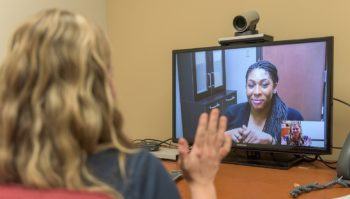Coronavirus Pandemic Shows Advantages Of Telehealth

With the restrictions the COVID-19 pandemic is placing on people who may be infected, the medical and mental health fields are searching for creative solutions to care for patients while protecting communities from widespread exposure, said Carly McCord, director of Telebehavioral Care at the Texas A&M University Health Science Center.
McCord, a clinical assistant professor in the College of Medicine and College of Education & Human Development, said telehealth and telebehavioral health are already being seen as solutions to some of the barriers to patient care specific to the new coronavirus.
“Telehealth has always been a great option, but COVID-19 is now forcing the option for a lot of providers across the nation,” said Katie Console, program coordinator at Texas A&M Telebehavioral Care and counseling doctoral psychology student in the College of Education & Human Development. “Everyone is now asking the question if health care and society as a whole are ready for a potential viral outbreak of this scale.”
Telehealth uses technology for direct service or as an adjunct to health care services. For example, the telehealth model uses video conferencing, wireless communications, remote data collection and image streaming so health care professionals can reach patients who cannot make it to a clinic.
This model mitigates the potential health care barriers of distance, lack of transportation, cost and a lack of providers. It works especially well for chronic disease management, both physical and mental.
“Right now, we have seen a surge of health care providers seeking to add the telehealth model to their practice. We recommend they first consider proper training and learn best practices to provide the best high-quality services possible to their patients,” McCord said. “Providers should not rush into the telehealth model without the proper supports. We offer online trainings and resources to help.”
Telehealth is an option that can also protect health care providers.
If a health care provider is believed to be exposed to COVID-19 while treating a patient, they are required to self-quarantine*. This means providers will be unable to see patients in-person until they are proven not to have the virus, a problem amid an already strained health care system. Similarly, patients may feel hesitant to seek help due to the fear of spreading the virus to their communities.
Officials advise those who believe they may have the virus to call ahead to their health care providers* to limit contact with others in waiting rooms. Telehealth and telebehavioral care could take these precautions to the next level.
McCord and the rest of the Texas A&M Health Telebehavioral Care program provide grant-funded telehealth counseling to underserved residents across Texas. The clinic also sells time blocks to organizations across the state, including institutions like the Washington County Jail, so they can offer mental health services “in-house.”
Texas A&M has led the movement toward telehealth through programs like this and the Center for Excellence in Forensic Nursing, a program designed to develop and implement a telehealth program to bring forensic nurse expertise to areas that may not have a forensic nurse available.
“Telehealth is a great option for care all the time, and this outbreak is no different,” McCord said. “We encourage the adoption of telehealth services as the model has proven effective time and time again as providers take the necessary preparation steps for high-quality care.”
This article by Mary Leigh Meyer originally appeared on Vital Record.





